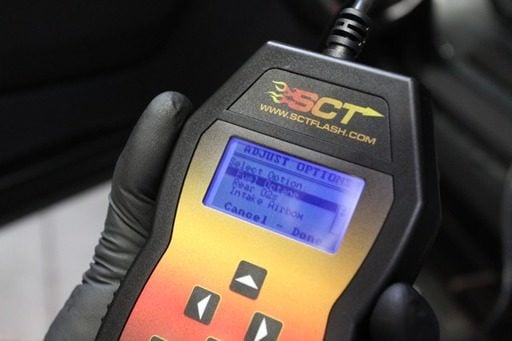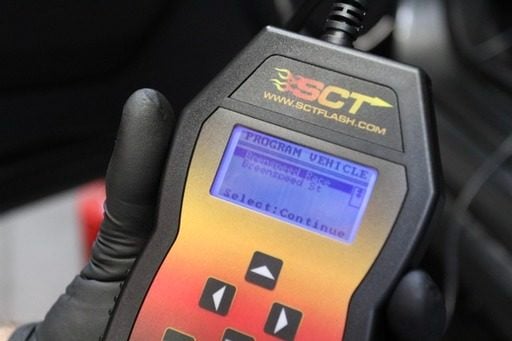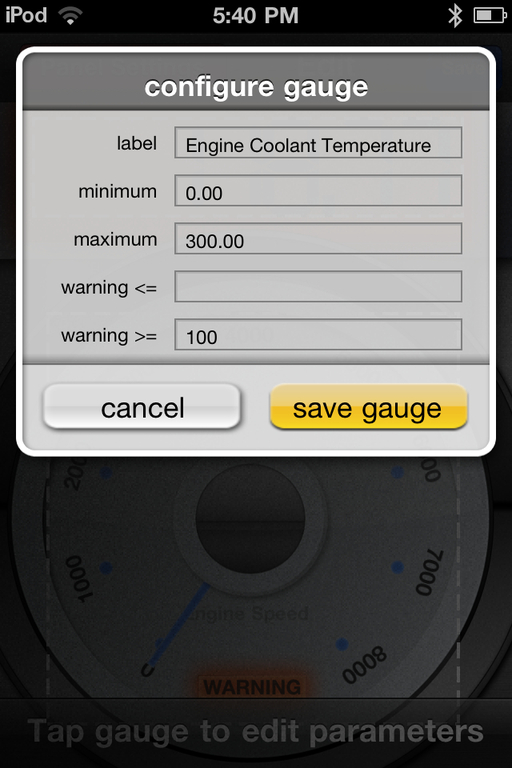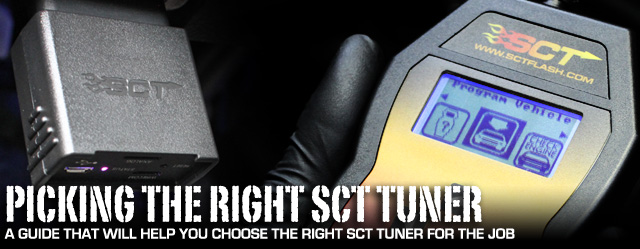 [1]
[1]
So after weighing the options, talking to your buddies, and calling a few shops, you have finally decided to settle on an SCT Flash [2] tuner. But the next big question arises; what the heck should I pick? Don’t blow your brains out with confusion just yet, we have a quick and dirty guide that will help guide you to your final destination.
While each SCT tuner has its own bells and whistles, there are many features all of the devices/products share…though the process of doing them may differ slightly.
“‘Which tuner do I need?’ is one of the biggest question we get, and with good reason, we have lots of different programmers,” said Tim Roi of SCT. “To help our customers choose the right programmer for them, we ask ‘What features are they interested in?'”
Roi continued, “Do they need to datalog their vehicle or do they want to measure the performance of their vehicle using the device? Are they going to program their vehicle and then simply leave the tuner in the trunk or are they interested in monitoring the vehicles OBD-II data while they drive? Do they have a smart phone? Are they interested in a wireless solution? What is their budget? All of these features come into play when choosing an SCT tuner.”
Pre-Loaded Tunes and User Adjustable Options
This means that if SCT supports a customizable, dyno-proven strategy tune for your vehicle, there is no need for the additional cost of a custom tune. SCT even has special tunes designed for popular air intake upgrades to further maximize horsepower. Except for the X3, which is specifically designed for custom tunes only, SCT tuners include a pre-loaded tune option.
A big benefit to SCT’s pre-loaded tunes is the ability to adjust them; there are a wide array of custom options that can be further explained on the SCT Flash website [3], though some popular features are axle ratio, tire size, speed limiter, WOT fuel, and idle speed.
Custom Tuning
A custom tune is a way to harness every ounce of horsepower from the modifications you have installed on your car. SCT’s authorized tuners can create a tune based on their tuning experience with common modifications, or even create a remote tuning session for wild applications like turbos and superchargers. Once a tune file is created, the tuner will E-mail it to you so that you can load it onto your SCT device.
All of SCT’s tuners can hold up to three custom tunes, except for the iTSX that can store ten. So let’s say you’ve got a daily driver that has a nitrous system installed, and you run race fuel at the track. You can upload the nitrous tune in a matter of minutes from the track, and then return the car back to stock (or another street-friendly tune) for the ride home. A “Return To Stock” feature keeps the vehicle’s original tune file stored in the SCT device for safe keeping.
Many custom and pre-loaded tunes come with User Adjustable Options, which allow you to tweak a wide range of the engine’s (and vehicle’s) perimeters. These include options for what octane pump gas is in the vehicle, what temperature the fans should come on, and even the gear ratios in your vehicle’s rearend. You can also set speed or RPM limits, advance/retard timing, and add or subtract fuel during wide open throttle.
Diagnostic Trouble Codes
Continuing with the shared options, is the ability to read and clear Diagnostic Trouble Codes (DTC) from the vehicle’s PCM. This is a great aid for checking and clearing any trouble codes that may arise.
Datalogging/Sensor Monitoring
The last similarity is monitoring and datalogging capabilities, which are a crucial tool when it comes to supplying tuners with valuable information. Also datalogging can be valuable by monitoring what is going on with the engine during a run at the track, logging perimeters like air/fuel ratio, coolant temperature, and air intake temperature.
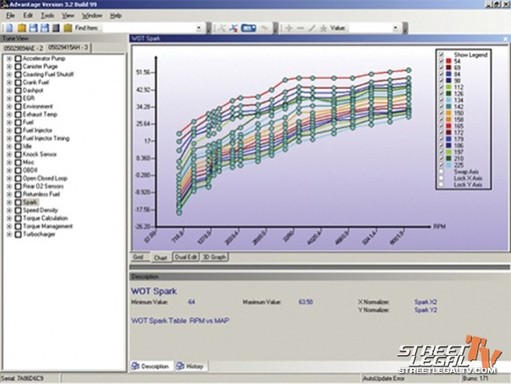 [5]
[5]SCT's Advantage software is a very popular datalogger that allows users to overlay information recorded from the vehicle's PCM into easy-to-read graphs.
The tuners can also monitor information coming from external sources by plugging them into one of the four analog ports on the tuner. Say you have a wideband or EGT sensor; just wire the 0-5 volt sensor output wire into the tuner’s analog port and it will log all that information, that can be displayed on the screen, or uploaded to a computer.
SCT’s Most Popular Tuner – The SF3
SCT’s SF3 is the most affordable tuner that does everything you need. “For the average enthusiast that simply wants to load a tune into their car to get maximum performance from their bolt-ons, we recommend our SF3/X3 device,” explains Roi. “It is the most economical tuner we have, but still has the ability to datalog the vehicle if required later.”
(Left) SCT's strategy tunes give the user a wide range of options, like octane level, disabling rear O2 sensors, and even a custom air intake. (Right) While the SF3 does support custom tuning as well, the X3 is designed specifically for custom tunes.
While it might look really basic with its no-frills display, the SF3 is actually SCT’s fastest flash tuner. The iTSX both send the tunes to the OBD-II receptacle before it’s uploaded to the PCM. Because the SF3 and X3 are hardwired, the tune is sent directly to the PCM.
Similar to the SF3, the X3 is designed for custom tuning only. It has all the same great features as the SF3, and it’s just as fast, but without the built-in strategy tune capability. The X3 is a popular choice for companies designing custom tunes to go along with a power adder. This helps prevent users from accidentally loading the strategy tune, rather than the custom tune designed to be used with those parts.
SCT’s Newest Tuner – The iTSX
 [8]No more worrying about cables, dongles or other bulky items; the iTSX fits in the palm of your hand and fits neatly onto the vehicle’s OBD-II port where it transmits the vehicle’s information directly to an (iDevice) Apple device. “Something not many of people don’t know about iTSX is 95% of SCT’s staff had no idea we were making it until eight months into the development – myself included,” said Roi. ” We knew this product was going to change the tuning industry and we didn’t want to risk an accidental leak or word getting out about what we were going to do.”
[8]No more worrying about cables, dongles or other bulky items; the iTSX fits in the palm of your hand and fits neatly onto the vehicle’s OBD-II port where it transmits the vehicle’s information directly to an (iDevice) Apple device. “Something not many of people don’t know about iTSX is 95% of SCT’s staff had no idea we were making it until eight months into the development – myself included,” said Roi. ” We knew this product was going to change the tuning industry and we didn’t want to risk an accidental leak or word getting out about what we were going to do.”
Let’s take a look at some of the iTSX’s capabilities.
Now that our graphics guys know how to create more gauge sets, watch for some very cool gauge themes & layouts shortly.
Installing the iTSX app is no different than installing any other application; log into the iTunes store with your free account and type in “iTSX” into the search bar. The download is free and does not require any additional sign up to use.
The functionality of the iTSX’s tuning process is largely unchanged over their SF3 tuners, though easy-of-use is improved with it’s color on screen prompts. The application will detect the vehicle it’s tuning and display the default settings on the tune, allowing the user to easily customize the tune with a myriad of adjustments.
 [9]
[9]For those of you refusing to buy Apple products, SCT now offers the TSX for Android phones as well. The Android is a Flash-based phone, so while it looks different than the iTSX, it is fundamentally the same.
The custom tuning support is where the iTSX really shines. With the ability to store up to 10 custom tunes (over three times the normal amount) the iTSX will load tunes through email or USB connection. This eliminates the need to open up an additional Windows-based SCT updater to load the tunes. Additionally, tuners can protect end users with custom tunes, by disabling the preloaded tune function so an incorrect tune can never be loaded.
Current gauge options come in the form of three numerical readouts, or one sweeping gauge with one numerical read out above it. Unlike a typical analog gauge that gives a fixed gauge sweep, the iTSX gauges can be programed for any specific range. For example, the engine speed could be displayed on the sweep-style gauge that only registers 4,000 to 7,000 rpm so you could have a much finer detail of when you are approaching the vehicle’s red line. Speaking of red line, all the gauge parameters come with both high and low settings that will trigger the gauge to show red once either one of these ranges have been triggered, which could even be used as a shift light.
Another added benefit of the iTSX is its performance test capability. Unlike many other applications that rely on GPS tracking to determine the tests, the iTSX actually uses the sensor outputs to calculate. From a stop, we selected the ‘Start’ button on the performance test. Once the vehicle starts to move, the iTSX detects the movement through the vehicle’s speed sensor.
The iTSX software is first downloaded from the Apple iTunes store. Before starting the software, make sure you pair the iPhone's Bluetooth with the iTSX device. From there, the potential of the iTSX can be unlock. While it is very similar to the TSX's functionality, we think the uploading experience on the iTSX is greatly enhanced.
SCT iTSX for Ford and GM Late-Model Vehicles
• Vehicle Tuning and Programming
• On-Screen Virtual Gauges with Adjustable Warning / Alert lights
• Monitor Vehicle Engine Data / Parameters via Virtual Gauges
• Huge Virtual Gauges on iPad ( 9.5” wide X 7.4” tall )
• 0-60 MPH Test: Virtual Speedometer & Graph with Estimated Horsepower
• ET / MPH Test: 1/8th mile & 1/4 mile ET / MPH with Estimated Horsepower
• Top Speed Performance Test
• Braking Performance Test with 60-0 MPH ET
• Reads & Clears Vehicle Diagnostic Trouble Codes

